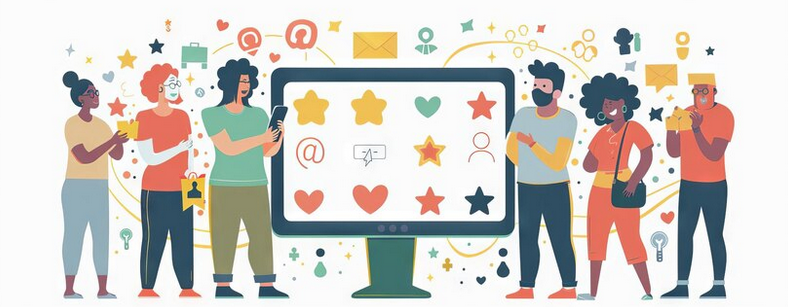Onboarding: Effective ways to attract and retain users
-
Larisa Shishkova
Copywriter Elbuz
Why do some companies retain thousands of users, while others lose them after a couple of weeks? The answer lies in one word - onboarding. Imagine how the puzzle pieces slowly and independently come together into an amazing picture, where each element plays an important role. How to build an onboarding process that attracts and retains users? Today I will share this secret. Onboarding is an art where every touch matters. User retention is not only about technology, but also about warmth, attention to detail, and a willingness to always support. I am ready to share practical advice, personal stories and successful examples so that your business radiates success and prosperity.

Glossary
🎉 Onboarding is the process of introducing a new user to a product or service to ensure comfortable and effective use.
✉️ Welcome email – a welcome email sent to new users to thank them for registering and provide initial information about service.
🎬 Training videos – video content created to explain the functionality and benefits of a product or service.
📊 Segmented onboarding – an onboarding process in which users are divided into groups based on various criteria to provide the most relevant experience.
📱 Splash Screen - the home screen of a mobile application that appears upon launch and is often used for branding and creation first impression.
🔔 Push Notifications - notifications sent to users on their devices to inform them about news, events and personalized proposals.
🔑 Registration process – the procedure for creating a user account, including entering personal data and confirming information.
💡 Visual hints – graphic elements indicating the functionality and capabilities of the application interface, helping users faster get comfortable.
📄 Educational articles – text materials created to explain complex aspects of using a product or service.
🛒 Path to first purchase - reducing steps and simplifying the process leading to a user's first transaction in a product or service.
👋 Greeting Users is the practice of creating a positive first impression through personalized greetings and interactions.
✅ Principles of effective onboarding - a set of rules and recommendations aimed at creating a successful process of user adaptation to the product.
🛑 Common mistakes in the onboarding process - typical errors and shortcomings that can negatively affect the user experience in the beginning of their interaction with the product.
Onboarding process and its benefits
A few facts about user behavior
When creating onboarding processes in my projects, I always adhere to the principle: the simpler and more intuitive onboarding for new users, the higher the likelihood of their long-term interaction with the product. The engagement rates speak for themselves.

Let's look at the statistics. About 55% of users who spent a sufficient amount of time learning the application in the first week after installation return to it in the next three months. This figure may vary depending on the specific product, but the general trend remains the same. Attracting the attention and interest of users at the initial stages is a task of paramount importance.
I can confidently say that those who actively use the software every day for the first month are more likely to continue using it in the future. This is backed up by the numbers: 90% of users who regularly interact with the app within the first month remain active.
It is important to understand that the key task at the onboarding stages is to retain the attention of users. About 82% of users who actively use the app in the second week become repeat customers.
But it's not that simple. Those users who have lost interest in the app by the third week require special attention and effort to engage them. At this point, I typically use game mechanics, incentives, and personalized messages to regain interest and maintain app usage.

Here are some examples I've used that have proven to be highly effective:
- 📧 Email newsletters with tips and life hacks for using the application.
- 🎁 Personalized bonuses and promotions.
- 📲 Reminders and notifications about new features and app updates.
What to do:
- Simplifying the onboarding of new users: Creating a clear and user-friendly interface.
- Personalized notifications: Taking into account user interests and behavior.
- Motivational promotions and incentives: Stimulating actions aimed at increasing activity.
What not to do:
- Ignoring Initial Feedback: Lack of feedback can result in losing a customer.
- Monotonous and boring communications: Monotonous messages may not attract the attention of users.
- Complex and confusing processes: Unclear usage paths will lead to user churn.
Best Practices Chart:
| What to do | Why it's important |
|---|---|
| 💡 Simplification adaptations | Increases likelihood of continued engagement |
| 📩 Personalized notifications | Maintains attention user and reminds about the product |
| 🎁 Motivating promotions and incentives | Stimulates active use and increased interest |
I am confident that carefully implementing these techniques will produce tangible results for your business. Approach the onboarding process with attention to detail and users, and success will follow.

Impact of onboarding on company profits
When I started implementing an onboarding system in my projects, the first thing I noticed was how quickly and effectively onboarding can change a company’s performance. What I can say with confidence is that onboarding helps users 🤔:
- 😃 Quickly familiarize yourself with the capabilities of the product
- ✔ Know how to use the product correctly
- ✨ Start interacting with the software immediately

My implementation experience onboarding
Let me share my experience of implementing onboarding in one of my projects. We had a priority task: to retain new users and minimize their churn in the first days after registration. We started by creating onboarding steps focused on the needs of our users.
I believe that spending time learning about users and their pain points is the best way to start. We carefully analyzed data and reviews to understand what problems our users have when using our product. The main pain points that we have identified 🤕:
- Difficulties in navigating the application
- Lack of understanding of the main functions of the product
- Insufficient understanding of the benefits of the product
How we solved these problems
I would advise you to consider creating step-by-step instructions and mini-courses for new users. In our case, we created interactive guides 📘 that walked users through every step. We implemented tips and notifications that explained how to use key product features and where to go for support.

Hint cards and video instructions
- 💡 Introduce interactive cards -tips directly into the application interface.
- 📺 Prepare short video instructions that visually explain how to use the product.
Successful Implementation Example
We ran a pilot with a limited group of users and saw a significant improvement in retention. After seven days of using the product, about 20% of users reported that they understood the product better, and the interaction with it became easier and more enjoyable.
I am sure that to achieve such results, constant feedback and the desire to adapt processes to the real needs of users are important.

Onboarding in numbers
To strengthen the argument, I’ll give you a few numbers 📈 :
- Companies that implemented onboarding increased user retention by 50%.
- Profits increased by 35% for businesses that invested in quality onboarding.
- User training time reduced by 70%.
These numbers confirm the importance and effectiveness of proper onboarding.
Onboarding Best Practices
- 📊 Use analytics and data to personalize onboarding.
- 🚀 Remember to involve user feedback to continually improve the process.
- 👩🎓 Train and support users every step of the way.

In my practice, based on these principles and data, I was able to successfully implement onboarding in several products, which led to increased profits and improved user loyalty.
Review Table
| What to do | What not to do |
|---|---|
| Conduct detailed user analysis | Ignore feedback |
| Create interactive tips and videos | Rely only on text instructions |
| Regularly update and adapt onboarding | Force users to go through long and boring instructions |
Thus, I believe that proper onboarding can significantly impact the growth of a company and the satisfaction of its users.
Key types of onboarding: My experience and recommendations
Training screens
When I first introduced training screens into our product, I tried to find a balance between useful information and too much data. Educational screens are one of the easiest and fastest ways to convey basic information to users. We decided to use training screens so that beginners could quickly get used to the functionality. For example, when registering, the user saw several screens with brief instructions that he could easily scroll through.

💡 Tip: Avoid being too detailed so as not to overwhelm the user. It is very important that each new information is short and to the point. I have personally brought our instructions closer to key points with positive results.
Welcome emails
Welcome emails have also become an important element of our onboarding. We've developed an email chain that starts with a concise greeting and ends with in-depth instructions and tips. This allowed us to smoothly involve users in the process of using the product. For example, in the first email the user received a greeting and information about where to find basic functions.

💡 Tip: Keep your emails concise and contain useful advice , not promotional materials. I have found that such emails not only increase engagement, but also reduce user churn.
Segmented Onboarding
This approach has proven particularly useful in our practice. We started segmenting users based on their preferences and behavior. For example, a new user could select his interests when registering, which allowed us to adapt the application interface to his needs. This not only improved the user experience, but also significantly increased satisfaction.
💡 Tip: Pay attention to detail when segmenting users. The more accurately you understand their needs, the better you can provide relevant content. I have always made sure to ask questions that truly help understand the user.

Training Videos
We introduced training videos to make the onboarding process more interactive and engaging . The video welcomed new users and explained the main features of the product. I've personally been involved in the creation of these videos and have found that emotional appeal and clearly structured content significantly increase engagement.
💡 Tip: monitor the quality of the videos and try to make them as informative as possible. Users appreciate the professionalism and care taken during their learning process. Personal appeals from the head of the company or leading specialists always work to your advantage.

Blank Screens
This technique is surprisingly effective. We started using blank screens to encourage users to take action. For example, a blank profile screen said “Add your first photo,” and this motivated the user to fill out the profile. I noticed that this simple but effective solution significantly increased user activity.
💡 Tip: Create emotional triggers to motivate users. Personally, I always try to make these screens look friendly and encourage action.

Review Table
| Onboarding Type | Usefulness | Disadvantages | Recommendations |
|---|---|---|---|
| Tutorial screens | 👍 Easy and fast way | 👎 May overload the user | 📌 Minimize the information load |
| Welcome email | 👍 Check email more often | 👎 May not be read | 📌 Keep emails short and useful |
| Segmented onboarding | 👍 Increases relevance | 👎 Requires resources | 📌 Ask the right questions |
| Training videos | 👍 Attractiveness | 👎 Bad internet reduces efficiency | 📌 Ensure quality and accessibility |
| Blank screens | 👍 Motivate action | 👎 May seem boring | 📌 Create emotional triggers |
Summary
When choosing onboarding methods, it is important to take into account the characteristics of your product and audience. As I have shown in my experience, the right combination of methods can significantly increase user engagement and retention.
How to improve a mobile application using onboarding
In my practice, I often come across the fact that properly organized onboarding can radically affect the fate of a mobile application. In this section, I would like to share my personal conclusions and recommendations based on many years of experience.
Design an attractive splash screen
When I started working on mobile applications, one of the first and very important elements that I paid attention to was the splash screen. This screen appears the first time the app is launched and should immediately grab the user's attention.

An attractive splash screen can convey your product's value proposition to the user in a matter of seconds. For example, in the project of an online electronics store that I worked on, we focused on unique advantages - the ability to pay when receiving goods, a wide range of products, profitable promotions and sales. This approach allowed us to significantly increase the engagement of new users.
My recommendations:
- 🌟 Make sure your value proposition is concise and clear.
- 🌟 Focus on visual appeal.
- 🌟 Use animations sparingly so as not to overload the user's device.
Request a subscription to push notifications
Push notifications may seem intrusive at first, but I've found them to be effective. According to statistics, the share of such notifications is 84% for Android and 47% for iOS. In one of my mobile app development projects, we implemented a strategy where users were prompted to sign up for push notifications with discounts and special offers immediately after installing the app.

My recommendations:
- 🌟 Explain to users why they need these notifications.
- 🌟 Do not abuse the frequency of sending notifications.
- 🌟 Provide an easy unsubscribe option.
Make the registration process as simple as possible
An overly complicated registration process often leads to user churn, and I can say this from my experience in the industry UX design. When we implemented simple and fast registration via social networks and email in one of our projects, the number of users who successfully registered increased noticeably.
My recommendations:
- 🌟 Give the user a minimum number of fields to fill out.
- 🌟 Provide the opportunity to register through social networks.
- 🌟 Eliminate the mandatory creation of a new login and password.
Give clients visual advice
When I was working on improving the UX for an application, I came to the conclusion that visual advice -Hints appearing at the right moment can significantly improve the user experience. We organized these prompts so that they appeared in stages, which allowed us to minimize the number of users who encountered difficulties in the early stages of using the application.

My recommendations:
- 🌟 Insert hints only where they are really needed.
- 🌟 Make the tips concise and understandable.
- 🌟 Organize a step-by-step demonstration of hints.
Supplement your content with educational articles and videos
To help users easily get started with a new app, I always recommend including educational articles and videos. In one of our projects to develop an educational application, we created a separate section with regular publication of educational videos and articles, which significantly increased user satisfaction.
My recommendations:
- 🌟 Create a separate section on your website or app for educational materials .
- 🌟 Publish new videos and articles regularly.
- 🌟 Make sure content is easily accessible and understandable.

Shorten your path to your first purchase with relevant offers
On Based on my experience, I can confidently say that providing relevant offers immediately after registering in the application significantly increases the likelihood of a first purchase. In one of the projects, we immediately showed users discount and promotional programs, which led to an immediate increase in conversion.
My recommendations:
- 🌟 Highlight the sentences on a separate page.
- 🌟 Focus on benefits and discounts.
- 🌟 Make information about offers available first.
Be sure to greet users
Welcome emails are a great opportunity to make initial contact with customers. During one of my projects, we sent welcome letters in which we talked about the benefits of our product, offered bonuses and discounts. The open rate of such letters was 46%, which is significantly higher than that of regular correspondence.
My recommendations:
- 🌟 Personalize your welcome email.
- 🌟 Indicate the clear benefits of cooperation with your company.
- 🌟 Include bonuses and special offers in your email.

Summary
Useful to do:
- 🌟 Make sure you have an attractive screensaver.
- 🌟 Implement a push notification subscription request.
- 🌟 Make the registration process as easy as possible.
- 🌟 Provide visual tips and tricks.
- 🌟 Add educational articles and videos.
- 🌟 Shorten your path to your first purchase with relevant offers.
- 🌟 Always welcome new users.
It is not useful to do:
- 🚫 Making registration too complicated and lengthy.
- 🚫 Impose push notifications without explaining their benefits.
- 🚫 Use the simultaneous appearance of a large number of hints.
- 🚫 Neglect regularly publishing educational materials.
- 🚫 Miss the opportunity to provide relevant offers right away.
I believe that following these guidelines will help make the onboarding process your strongest tool for attracting and retaining users.

Practical application of psychological principles in onboarding
When I was developing onboarding for one of my projects, I became convinced that the greatest effect is achieved by introducing psychological principles. I understand that starting a new product or service can be stressful for many people, so it's important to make the process as clear and motivating as possible.
🧠 Using psychology to engage users
First and foremost, I always strive to use application psychology. For example, when creating a progress bar that shows the user their progress while using the product, I noticed a significant increase in engagement. For example, indicators like “Step 1 of 3 completed” or “Only 2 steps left to complete” really help the user realize how close they are to completing a task.
And it works! I can confidently say that by showing users small steps and achievements, we subtly motivate them to continue using the product. 
📌 Explaining the value of your product
One of the key points of onboarding is explaining to users the value of your product . I believe that the user should understand how your product will help him solve a specific problem. In my experience, this has always resulted in increased user retention.
While working on a project for a client, I was convinced that demonstrating the application's capabilities, such as paying for services, transferring money and receiving cashback, significantly increases the likelihood that the client will begin to actively use all functions immediately after installation .
📝 Creating a Personal Onboarding Experience
I always recommend involving users in the onboarding process. For example, when I was working on a project for a startup, we created a feedback system and constantly improved the onboarding process based on user opinions. This made it more interactive and useful, which I believe is best practice.

👇 Useful recommendations
Using the methods that I described above, you can significantly increase effectiveness of onboarding. Here are a few recommendations that I've found work particularly well:
- 📊 Use progress bars: Indicators help users see their progress and motivate them to continue.
- 💬 Explain the value of your product: Tell users how your product will help them solve specific problems.
- 🤝 Listen to users: implement a feedback system and regularly improve your processes based on user feedback.
- 🧩 Personalize the experience: Create an onboarding experience tailored to each user's unique needs and experiences.
📊 Best Practices Chart
| What to do | What not to do |
|---|---|
| Use progress bars | Ignore the importance of demonstrating achievements |
| Explain the value of the product | Leave users without information |
| Involve users in the process | Ignore feedback |
| Personalize onboarding | Offer one approach for everyone |
So I can confidently say that successful onboarding requires attention to detail and the use of psychological principles to motivate and engage users. By following these recommendations, you can significantly improve the effectiveness of onboarding in your business.

Common mistakes in the onboarding process
In my practice, I have repeatedly encountered situations where companies made critical mistakes in the onboarding process. This led to the loss of users and, as a result, to a decrease in revenue. Based on my experience and knowledge in this area, I want to talk about three common mistakes that can and should be avoided.
Lack of active interaction with users after the first session
When users first onboard and start using your product, this is only the beginning of long-term communication. However, many companies make the mistake of stopping active interaction with customers after completing the first stage. 📉

I can safely say that such companies risk losing users, because without proper attention, interest in the product quickly fades. For example, in one of my mobile app development projects, we initially did not pay enough attention to follow-up interaction and customer retention. As a result, despite the successful launch, the number of active users began to decline a few weeks after the launch.
To avoid this problem, I suggest several tactics:
🔥 Regular notifications and reminders new products and updates.
🔥 Encourage survey participation and feedback to increase engagement.
🔥 Creation of specialized content aimed at in-depth familiarization with the functionality of the product.
Insufficient performance of the web resource during onboarding
The worst thing that can happen during the onboarding process is technical glitches and poor performance of the site or application . If pages don't load, the interface is sluggish, or doesn't work properly, it can instantly turn users away. 
I am convinced that insufficiently stable operation of a web resource damages the company’s reputation. In my experience, there was a case when I worked with an electronic trading platform, the site of which had serious performance problems precisely at the peak moments of traffic. This led to massive user departures. We spent significant time and resources on optimization, wrote detailed technical specifications for programmers, and achieved significant productivity improvements.
Recommendations for improvement:
💡 Regular performance testing and eliminating bottlenecks.
💡 Using CDN technology to speed up page loading.
💡 Conducting load testing before large advertising campaigns.
Inappropriate attempts to explain all the features of a product at once
Another common mistake is redundant information provided to users at the beginning of their acquaintance with the product. Try to avoid overloading new users with data. 📊

On one of my projects, we encountered a problem when, at the onboarding stage, we tried to convey to users all the possible functions and capabilities of the product . Ultimately, this led to confusion and pushback on the part of customers as they felt overwhelmed with information. We revised the strategy, made onboarding more step-by-step and focused on key functions.
How to optimize the process:
✔️ Focus on key functions and gradually introduce additional functionality.
✔️ Using micro-trainings and short video lessons for explanations.
✔️ Interactive learning tools and tooltips.
It is important not only to avoid these mistakes, but also to constantly analyze the results and make adjustments to the onboarding process. This is the only way to create an effective and efficient strategy to retain users.
Summary and recommendations
| Error | Solution | Example |
|---|---|---|
| Insufficient interaction | Regular notifications, surveys, specialized content | Mobile application |
| Low resource performance | Testing, optimization, use of CDN | Electronic trading platform |
| Redundant information during onboarding | Focus on key functions, micro-trainings, interactive tools | Social network |
I am confident that by following these recommendations, you can significantly improve the onboarding process and attract the attention of users, retaining them on a long-term basis. I hope these tips are useful for your business. 
Onboarding Basics for User Acquisition and Retention
Onboarding Basics for Attracting and Retaining Users
🛠️ Developing effective onboarding begins with properly understanding what exactly attracts and retains a user’s attention on a website or app. From my own experience, I have seen how important it is to provide the most simple and intuitive information possible at the first stage. The user must quickly understand the core value of the product, without getting bogged down in overloaded interfaces and lengthy explanations.
Nowadays, the user's attention is unfocused by the abundance of information, but the requirements for the quality of the interface and the information provided are invariably high.
Practical advice that I can give:
🌟 Interface optimization
The interface should be simple and intuitive. Start by developing easy navigation and a sleek design that won't distract users from the main content. I always strive to ensure that in my projects every interface element is in its place, without raising questions among users.

🌟 Minimizing user effort
To make it easy and quick for the user to understand why your product is needed and what benefits it will bring, provide clear and concise instructions. For example, using short videos and simple graphs can significantly reduce the time to learn a product. From personal experience I can say that this works much better than long text manuals.
🌟 Personalized content
Tailor content to each user's needs. In my projects, I always try to segment users and provide them with targeted emails, tips and recommendations based on their previous behavior. Such personalization helps not only attract new users, but also increase their loyalty.

🌟 Feedback
Collect and analyze user reviews. Constantly ask them what can be improved. For example, during the development of one of my projects, I actively used surveys and chats to collect user opinions, which allowed me to quickly make the necessary adjustments.
📝 Examples of successful companies
❇️ Dropbox: They developed an exceptional onboarding consisting of interactive guides and videos. This approach allowed us to reduce the failure rate at the initial stages of interaction with the product.
❇️ Slack: They implemented onboarding by sending useful tips and recommendations for using the service, which significantly increased user engagement.
🌿 My recommendations
💡 I would recommend you consider the following aspects:
- 📊 Statistics and Testing: Use analytics and A/B testing to determine the most effective onboarding methods.
- 🚀 Step-by-step instructions: Create step-by-step instructions or training videos for new users.
- 💬 Support Chat: Implement a support chat to quickly resolve any user issues.

Summary and best practices
| Helpful Steps | What to Avoid |
|---|---|
| Simple and intuitive interface | Complex and overloaded interfaces |
| Clear and concise instructions | Long and boring texts |
| Content personalization | Universal approach |
| Collecting and analyzing reviews | Ignoring feedback |
I'm confident that by following these recommendations, you can improve your onboarding process and significantly increase user acquisition and retention. This conclusion is based on my experience and I am confident that by implementing such practices, your business will be successful.

Skechers Competencies
Company Skechers is one of the world leaders in the production and sale of footwear. Founded in 1992, Skechers offers a wide range of footwear for men, women and children, including sneakers, sandals and training shoes. ![]()
Main tasks and goals
The main goals of the company are attracting new users and retain existing customers by improving the onboarding experience. Skechers strives to increase the conversion of visitors to active users, as well as reduce the rate of customer churn.
Statement of the main problem
The main problem faced by the company is lack of user involvement in the initial stages of using mobile applications. This resulted in low activation rates and high failure rates.
Audience
Skechers' key target audience includes:
- 🏃♂️ Athletes and active lifestyle enthusiasts life
- 👟 People who follow fashion trends in shoes
- 🧒 Parents looking for high-quality and comfortable shoes for children

Key interests of the target audience
- 🛍️ High quality products
- 🎨 Wide range of models
- 📦 Convenient purchase and delivery
- 📲 Easy to use mobile application
Onboarding strategies and results
To solve the company's problems, the following onboarding strategies were implemented:
Training screens
On the first At this stage, users are faced with tutorial screens that directly and clearly describe the main features and benefits of the application.
Invitation letters
Users receive Invitation letters, which includes brief instructions on how to use the application, as well as a bonus in the form discounts on your first purchase.
Segmented onboarding
Using segmented onboarding, which allows you to tailor the information content to the user depending on his interests and previous shopping experience.
Tutorial videos
The application has tutorial videos that explain how to use the main functions.
.gif)
Blank screens
Purpose of blank screens – present users with the main functions of the application when they do not yet have data to display the content.
Results
These strategies led to the following specific results:
- 📈 Increased conversion of new users by 25%
- ⏳ Reduction in user registration time by 30%
- 🔄 Increase in repeat purchases by 15%
- 📉 Reduce bounce rate by 20%
"We strive to create a memorable experience for our users from the first step. Implementing thoughtful onboarding techniques has been key to achieving our marketing goals." — Rose Lambert, Skechers representative.
Key Achievements
| Metric | Result |
|---|---|
| Conversion | ↑ 25% |
| Registration time | ↓ 30% |
| Repeat purchases | ↑ 15% |
| Failure Rate | ↓ 20% |
These solutions not only helped Skechers attract new users, but also significantly improve the level of interaction with them, which has a positive impact on overall business performance.
Frequently asked questions on the topic: Onboarding - Effective ways to attract and retain users
Thank you for your attention and desire to be better! 🎉
That's it! Now you have learned that this onboarding process is not just a set of steps, but the real art of attracting and retaining users. Each stage, from the first seconds of acquaintance to full integration and loyalty, can become a key element of success. Remember, effective strategies used by market leaders can be your secret to success. Put your knowledge into practice and watch your business thrive thanks to smart onboarding.
What do you think? Leave a comment below - your opinion matters! 🚀

- Glossary
- Onboarding process and its benefits
- Impact of onboarding on company profits
- Key types of onboarding: My experience and recommendations
- How to improve a mobile application using onboarding
- Practical application of psychological principles in onboarding
- Common mistakes in the onboarding process
- Onboarding Basics for User Acquisition and Retention
- Skechers Competencies
- Frequently asked questions on the topic: Onboarding - Effective ways to attract and retain users
- Thank you for your attention and desire to be better!
Article Target
Informing about the onboarding process and its benefits, providing useful insights for creating successful onboarding.
Target audience
product managers, marketers, UX designers, entrepreneurs
Hashtags
Save a link to this article
Larisa Shishkova
Copywriter ElbuzIn the world of automation, I am a translator of ideas into the language of effective business. Here, every dot is a code for success, and every comma is an inspiration for Internet prosperity!
Discussion of the topic – Onboarding: Effective ways to attract and retain users
Informing about what onboarding is, its key stages and processes that help attract and retain users. Examples of successful companies using effective onboarding strategies, plus tips and tricks for creating a successful onboarding experience for your business.
Latest comments
15 comments
Write a comment
Your email address will not be published. Required fields are checked *



















John Smith
I recently started understanding onboarding for our startup. How critical is it to the early success of the application? 🤔
Anna Müller
John Smith, oh, this is of utmost importance. In our company, we introduced gamification into onboarding, and this increased user activity by 20%! 😎
Pierre Dubois
Anna Müller, in what form is gamification? I'm interested in using it for our mobile application.
Carmen González
Pierre Dubois, we have added tasks and rewards for completing them. Users love achieving goals!
Marco Rossi
I doubt all these newfangled strategies work. 😒
Łukasz Nowak
Marco Rossi, it depends on the target audience. Young users love interactive elements, so gamification may be just what you need.
Serhiy Ivanenko
Łukasz Nowak, I agree. Personalizing the onboarding experience is especially important to make each user feel special. For example, Tinder uses names and interests right out of the box.
Isabelle Laurent
Serhiy Ivanenko, that's it! We need to show the user the value of our app right away, otherwise they will leave.
Лариса Шишкова
The premise of onboarding is to attract and retain users through positive first impressions. The approach to this process must be carefully thought out. For example, Dropbox is great at showing value right from the start. What other companies do you admire for their onboarding processes?
Pierre Dubois
Larisa Shishkova, I like how Duolingo introduced learning through play. They made learning languages fun from the very beginning. 🎯
John Smith
Yes, Duolingo is really cool! I also heard that Airbnb cares a lot about onboarding new users and hosts.
Anna Müller
That's right, John Smith. They use personalized videos and step-by-step instructions for beginners. 🚀
Carmen González
Don't forget about Slack. Onboarding is so simple and intuitive that even those who have never used IT products can easily adapt.
Łukasz Nowak
I agree, simplicity and clarity are key. It's always better to explain everything step by step and avoid information overload.
Marco Rossi
I'm not sure it's all that important. They make noise out of nowhere. 🤷♂️